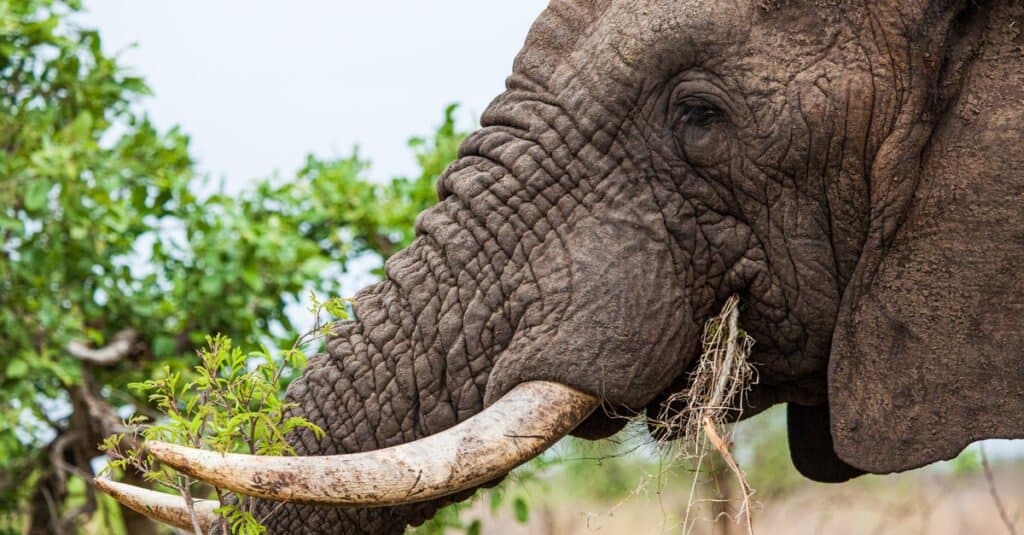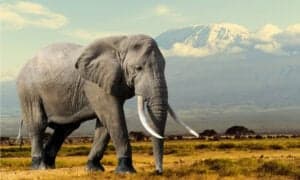From their floppy ears to their giant trunks to their truly massive size, there’s a lot that stands out about the elephant. But, elephant tusks are both a valuable tool and a potential liability for these gentle giants. The desire for ivory has made elephants popular targets for illegal poaching, and it can have a devastating impact on their populations. Here’s everything you need to know about elephant tusks, from what they’re made of, to what purpose they serve the elephant to why they’ve become such popular fashion symbols throughout the world.
What Are Elephant Tusks?
A tusk is simply a tooth that extends beyond the mouth, and like any other evolutionary trait, they’ve stuck around because they manage to be a useful utility tool for the creature. Elephants aren’t the only mammals with tusks either. Elephants are distantly related to the tusked woolly mammoths that existed millions of years ago — but tusks can also be found on walruses, pigs, and the rare narwhal. In most animals, tusks are an example of elongated canines — the teeth that are used to rip apart food. But, thanks to the fact that elephants are herbivorous, their tusks are constructed from elongated incisors — teeth that are used for crushing food. In fact, elephants don’t have any canine teeth whatsoever.
How Do Elephants Use Their Tusks?

©AndreAnita/Shutterstock.com
While it was once believed that the use of tools was a characteristic that separated man from the animals, it’s become apparent over the past few decades that this isn’t the case at all. Elephants are one of the most sophisticated tool-using animals on the planet, and that’s thanks to both their big brains and the combination of both tusks and a trunk.
Elephants also use tusks as a weapon and a defensive tool. An elephant’s trunk is one of its most important tools for interacting with the world and is one of the most sensitive parts of its body. Since it’s used for eating, breathing, and drinking water, the protrusions from the trunk extend out to keep it safe from attack. And in the same way that bucks use their antlers to vie for status among their brethren, male elephants use their tusks to intimidate rivals and sometimes to battle for territorial or breeding rights.
But, the most common and important role that the tusks serve is as a tool for foraging. Elephants will use tusks to strip the bark from trees which can then be eaten, providing an important balance of fiber to the elephant’s diet. But these clever creatures can also use their tusks to forage in more ingenious ways. By employing its tusk as a shovel, elephants can uncover water beneath dried-out riverbeds — and they can even dig to discover vital minerals and salts that are essential for a balanced diet.
These animals are capable of using their tusks as tools, but they also express the rare capacity to actually craft tools of their own — and tusks play a critical role in this process. Elephants have long been recognized using branches to swat off flies and fan themselves against the heat, but researchers discovered that they’re actually capable of adjusting these branches in the wild to be more efficient. They use their tusks and feet to strip and adjust the size of branches. And in many cases, tusks can be used to carry heavy loads from one place to another. Tusks are a valuable tool, but the elephant manages to make them significantly more valuable thanks to its impressive intelligence.

©iStock.com/Wayne Marinovich
What Are Elephant Tusks Made Of?
If you understand the anatomy of a human tooth, you have a decent understanding of the structure of an elephant’s tusk. The structure here is fundamentally the same, with four parts that make up the anatomy of the tusk. An outer layer of enamel serves as a protective coating for the deeper parts of the tooth. Dentin constitutes the next layer, and it translates to the deeper nerve endings sensations like heat and cold. A layer of cementum holds the tusk in place and prevents it from coming loose. The pulp constitutes the very center of the tusk, and it’s a bundled mass of nerve endings, blood vessels, and connective tissue. The pulp distributes the nutrients and minerals needed to keep the tusk strong and healthy.
In fundamental terms, these structures are built the same as a human tooth — but the unique physiology of the elephant ensures that there are differences. The fact that the tusk protrudes beyond the body and is used as a rough tool means that the enamel often tends to wear down quickly. In the same way that most humans have a preferred hand, an elephant has a preferred tusk that can be identified by the one with the most worn-down enamel. And while the part of the tusk that we can see is intimidating in its own right, it’s just a fraction of the entire tusk — most of which is buried deep in the elephant’s mouth. Unlike teeth, tusks keep growing over time. You can even approximate an elephant’s age by comparing its tusk size to others of its age and species.
Why Are Elephant Tusks So Valuable?
Chemically, there’s no difference between a tooth and a tusk, but ivory continues to be a major business — and one that’s driving an illicit elephant poaching trade. Instead, its value comes largely down to cultural status and scarcity. The difficulty of hunting an elephant in older times — accompanied by the fact that elephants are found in a relatively limited geographic density — meant that items made of ivory were possessions to be treasured. And the fact that ivory is soft, pliant, and easy to craft with made it a prized exotic good throughout the world. An expansive African ivory trade flourished in the 15th through 19th century, but they continued to be a source for popular luxury items well into the 20th century. Elephant ivory was used for piano keys well into the 1980s. And while significant inroads were taken near the end of the century to ban the trade, some countries have been slower to embrace the movement than others. China in particular has been one of the largest consumers of ivory. While the sale of ivory products was banned in 2017, the rising young and wealthy generation recognizes the appeal of ivory as a status symbol.
Can An Elephant Survive Having Its Tusks Removed?
Humans may be able to survive having a tooth pulled, but the situation is more serious for elephant tusks. Since the tusk is deeply implanted in an elephant’s skull, fully extracting it is significantly more complicated. While it could technically be possible to sedate an elephant and remove its tusk, it would be a difficult and painful process as a nerve runs directly through the tusk.
Regardless, poachers have neither the means nor interest in any such delicacy. Elephants can still be incredibly lethal creatures, and it’s far easier to simply kill an elephant and then take their tusks. Even if it were a painless procedure, many elephants rely on their tusks to accomplish essential survival skills. Being left without the use of a tusk is not dissimilar to losing access to a hand.
Due to the ivory trade, nearly 90% of African elephants have been eradicated in the past century. It is estimated that 415,000 wild African elephants are alive today. Asian elephants are on the decline too, with an estimate of only 30,000 left in 2017. They are still being poached in some countries.
Do All Elephants Have Tusks?
While many elephants use their tusks as valuable tools and weapons, not all elephants even have tusks. Traditionally, male and female African elephants possess tusks, while only some male Asian elephants have prominent tusks. Smaller tusks can be found in both female and male Asian elephants.
But, both species of elephant are experiencing increased instances of members without tusks. As poachers kill off elephants with the most prominent trunks, they’re taking them out of the breeding pool. Today, half of the female African elephants are born with no tusks at all, and that trend is happening in males as well. It’s a recent, rapid, and worrying development — but researchers believe that this tusk-less trait could become the dominant standard.
Are Other Animals With Tusks at Risk From Poachers?
Elephants aren’t the only animals that are hunted for the ivory of their tusks. Walrus ivory was an important component in many native cultures that relied on their meat for survival, and it’s hypothesized that Vikings may have driven Iceland’s walruses to extinction out of a desire for ivory. Various species of whale have also been poached for ivory throughout history. There’s even a thriving — if significantly smaller — market for warthog tusks in the tourist industries of South and East Africa. And while hippopotamuses don’t have traditional tusks, their prominent canines are also popular targets for illicit poachers.

©iStock.com/MagicColors
Up Next…
Fascinated by super long teeth? Read more about creatures with tusks.
- The Narwhal Tusk: The World’s Longest Tooth Ever wonder who has the longest tooth? A narwhal!
- News: Mammoth Tusk Found Impossibly Far Out At The Bottom of The Ocean Read about this amazing archaeological discovery at the bottom of the ocean.
- The Extinct Walrus: How Vikings Hunted a Walrus to Extinction Sadly, Vikings hunted the Icelandic Walrus to extinction in search of its ivory tusks.
The photo featured at the top of this post is © Carfield Photography/Shutterstock.com
Thank you for reading! Have some feedback for us? Contact the AZ Animals editorial team.






